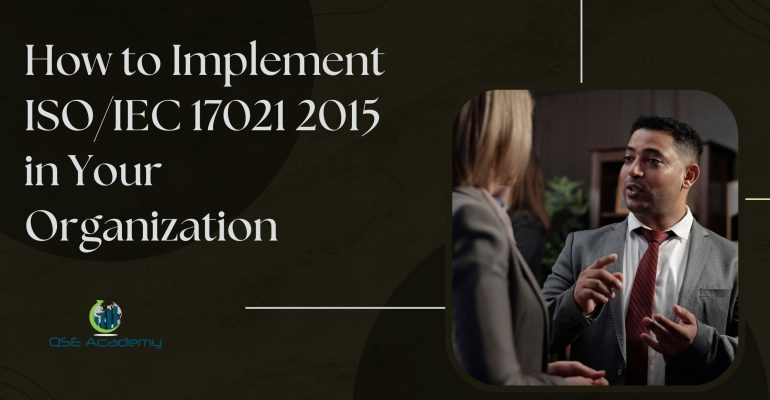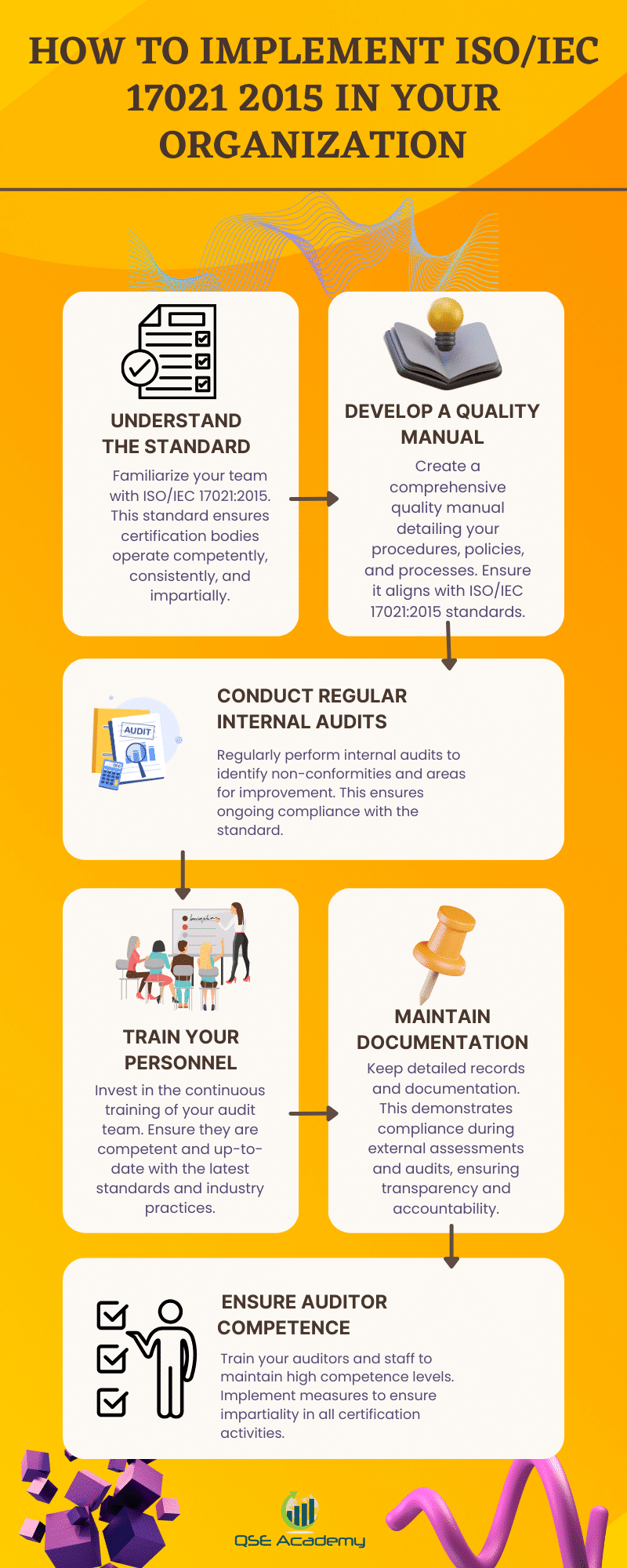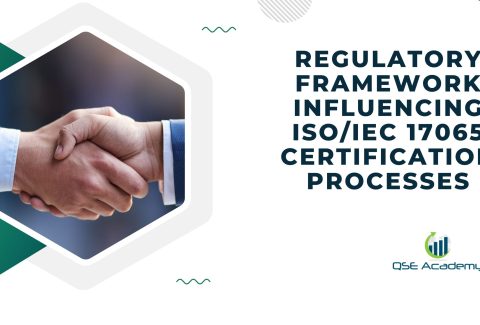How to Implement ISO/IEC 17021 2015 in Your Organization
Staring down the barrel of a complex standard like ISO/IEC 17021:2015 might seem daunting at first. This standard sets forth requirements for organizations that provide audit and certification of management systems. It’s a marker of quality and reliability, crucial for organizations in the business of certification. Here’s how to channel this challenge into a structured pathway for your organization’s success.
Before changing gears, it’s pivotal to understand the essence of ISO/IEC 17021:2015. The standard ensures that certification bodies operate in a competent, consistent and impartial manner. Adopting it can elevate your organization’s authority and trust within the industry. Now, let’s embark on a journey to seamlessly weave the ISO/IEC 17021:2015 standard into the fabric of your organization.
In the following article, we’ll outline a roadmap from the initial groundwork to the ongoing maintenance post-implementation. Guidance will span across planning, development of your management system, and embracing the standard’s core principles. We’ll navigate through the certification maze and tackle outsourced activities. By the end, you ought to be primed to not only apply the standard but also to sustain and enhance your certification body’s excellence.
Initial Steps in Implementation
Implementing ISO/IEC 17021:2015, which sets the standard for certification bodies issuing management system certifications, is a strategic decision that can enhance the overall performance and integrity of certification services. Before taking the initial steps towards implementation, a thorough understanding of its key principles and requirements is crucial. This ensures that the certification services are competent, consistent, and impartial, aligning with the overarching aim of ISO/IEC 17021.
The first and fundamental action in the implementation journey is a Gap Analysis. This involves a detailed assessment of an organization’s current practices in relation to the requirements stipulated in ISO/IEC 17021:2015. The gap analysis helps to highlight the areas in need of improvement, which can then be methodically addressed.
Subsequently, setting up a dedicated Implementation Team is imperative for a successful ISO/IEC 17021:2015 application. The team should be composed of individuals who are well-versed in types of management systems, including the senior management, to ensure that the necessary resources and support are provided. Furthermore, defining the team’s roles and responsibilities clear-cut will facilitate a smooth and efficient process.
Implementing ISO/IEC 17021:2015 requires diligent preparation and execution, as the standard affects various facets of the certification process—from documentation requirements to the making of certification decisions. Creating a structured plan guided by the Initial Gap Analysis report ensures that every required action is taken thoughtfully, moving the organization closer to achieving accreditation for its certification activities.
| Task | Responsible Team Member(s) |
| Gap Analysis | Lead Auditor, Quality Manager |
| Establishing Implementation Team | CEO, Quality Manager |
By maintaining conciseness and clarity, the organization can embark on the implementation journey with confidence, culminating in an accrual of benefits in the field of quality.
Planning the Implementation
Planning the implementation of ISO/IEC 17021:2015 is a critical step for Certification Bodies (CBs) that aim to conduct certification of various management systems. These systems could include but are not limited to quality, environmental, or food safety management systems. As a CB prepares for the accreditation process, setting clear objectives and goals is fundamental to ensure technical competence and effective certification services.
The journey begins with the development of a detailed implementation plan highlighting key timeline milestones. Doing so ensures that all activities align with the overarching targets and the CB can monitor progress throughout the certification process.
Resource allocation is another significant aspect of the planning phase, where the CB must identify necessary resources, such as skilled personnel, financial backing, and technological support. Equally crucial is ensuring that these resources are available and aptly allocated to facilitate a smooth accreditation process and subsequent certification activities.
Training and awareness programs are essential; they equip staff with the required understanding of ISO/IEC 17021:2015 standards and instill recognition of the benefits of adherence. These programs not only cover the generic requirements but also emphasize the importance of maintaining management system requirements in certifying different types of management systems.
A structured and concise planning approach is indispensable, one that will eventually lead to successful ISO/IEC 17021-1 accreditation.
| Milestone | Objective | Completion Target |
| Initial Review | Gap analysis | Month 1-2 |
| Resources | Allocation of assets | Month 3 |
| Training | Staff readiness | Month 4-5 |
| Mock Audit | Process validation | Month 6 |
| Final Review | Documentation check | Month 7 |
| Apply | Accreditation | Month 8 |
In summary, meticulous planning of the implementation phase is central to becoming a reputable management system certification body in the field of quality and beyond. It is a strategic process that encompasses setting objectives, allocating resources, and enhancing staff capabilities, all while staying on schedule and within budget.
Developing the Management System
Developing a robust management system is a fundamental requirement for organizations seeking certification under ISO/IEC 17021:2015, which sets the criteria for certification bodies providing audit and certification of management systems. When establishing this framework, the organization must start by creating the necessary documentation. This includes drafting policies, procedures, and manuals tailored to its operational needs. Each document should be clearly written and structured, ensuring that the system is both consistent and easily understood by all employees involved in certification activities.
Documentation should not exist in a vacuum. An effective management system involves meticulous document control procedures, ensuring all records are accurate, up-to-date, and protected against unauthorized access or loss. This extends to maintaining a comprehensive record system that stands up to the scrutiny of both internal and external audits.
Communication is the glue that holds the management system together. Organizations must implement efficient communication strategies that facilitate the flow of information. Regular updates and a clear chain of communication ensure that all staff members are informed and have the ability to engage with the development and execution of the system.
Organizations navigating the ISO/IEC 17021 standard must pay particular attention to these areas, as they underpin the certification readiness and ultimately support the success of the certification process. By adhering to these steps, businesses not only fulfill requirements but also forge a path toward continuous improvement and technical competence.
| Key Component | Description |
| Documenting the Management System | Creation of clear, consistent policies, procedures, and manuals |
| Control of Documents and Records | Develop procedures to manage documents and maintain secure, accurate records |
| Internal Communication | Implement strategies for effective information flow, staff awareness, and engagement |
This table summarizes the crucial steps in developing a management system that aligns with the ISO/IEC 17021:2015 standard.
Implementing Key Principles
Ensuring impartiality is paramount when implementing ISO/IEC 17021:2015. Certification bodies must take decisive actions to eliminate conflicts of interest to uphold the credibility of their certification services. One effective strategy is to establish impartiality committees tasked with enforcing clear protocols that safeguard unbiased operations.
A table to illustrate key aspects:
| Principle | Actions | Tools and Mechanisms |
| Ensuring Impartiality | Conflict of interest checks | Impartiality committees, Transparency protocols |
| Building Competence | Selecting qualified personnel, Conducting training | Professional development programs, Competence criteria |
| Maintaining Responsibility and Accountability | Clarifying roles, Implementing accountability measures | Job descriptions, Performance reviews |
Building competence within the certification body is also essential. This means meticulously choosing personnel based on stringent criteria and providing them with thorough training. It is also critical to ensure that the process of professional development is ongoing, allowing audit teams to remain up-to-date with standards and practices within the field of quality.
Responsibility and accountability must be clearly delineated within the organization. This not only involves defining specific roles and responsibilities for all involved in the certification process but also entails setting up robust accountability mechanisms. These checks and balances ensure each step—from document preparation to making certification decisions—is carried out with technical competence and in accordance with ISO/IEC 17021:2015 requirements.
Finally, it is important to remember that the certification body’s performance is under continual scrutiny. The accreditation process demands maintaining high standards of quality management across all certification activities. The certification of management systems must reflect this commitment to excellence and compliance with all standard requirements, including the preparation of appropriate sample formats and checklists necessary for effective internal audits.
With these key principles in mind, certification bodies can navigate the intricacies of ISO/IEC 17021:2015 and provide trustworthy and high-quality management system certifications, ensuring their service meets the complex needs of their clients.
Certification Process Implementation
Implementing the certification process under ISO/IEC 17021:2015 involves meticulous planning and execution to ensure that certification bodies adhere to the rigorous standards necessary for certifying management systems. Here’s how the process unfolds:
Application and Contract Review
- Handling Initial Inquiries and Applications: Prospective clients reach out to certification bodies to express interest in obtaining certification. Certification bodies must respond appropriately and guide applicants through the next steps.
- Reviewing and Approving Contracts: Once initial contact is made, a review of the requirements and the proposed contract ensures that both parties understand the obligations and scope of the certification.
Audit Planning and Execution
- Developing Detailed Audit Plans: A well-structured audit plan is critical. It outlines the audit’s scope, criteria, schedule, and the roles of the audit team members.
- Conducting On-Site Audits and Collecting Evidence: The audit team visits the client’s site to gather evidence, assess compliance, and evaluate the implementation of management systems against the specified standards.
Certification Decision-Making
- Criteria and Processes for Making Certification Decisions: Certification bodies make decisions based on the evidence collected during the audit. This decision must be impartial and reflect the competence of the organization in adhering to the standards.
- Ensuring Impartiality and Competence in Decision-Making: The integrity of the certification process relies on objective and competent judgment. Certification bodies have measures in place to safeguard impartiality and employ proficient decision-makers.
| Certification Process Step | Key Action Items |
| Initial Contact | Manage inquiries, applications, information dissemination |
| Contract Review | Contract examination, clarification of terms, scope finalization |
| Audit Planning | Formulate detailed audit plan, team selection, logistics setup |
| Audit Execution | Perform on-site audits, evidence collection, compliance check |
| Decision-Making | Analyze audit findings, render unbiased certification decisions |
This structured approach, mandated by ISO/IEC 17021:2015, ensures a uniform risk assessment and enhances confidence in certification outcomes for all types of management systems.
Management System Maintenance
Maintaining a management system is an ongoing process that ensures continuous improvement and compliance with the ISO/IEC 17021 standard. This part of the standard focuses on how certification bodies should not only audit but also maintain the management systems they certify. Here are the essential elements for effective management system maintenance:
Internal Audits:
An integral part of maintaining a management system is conducting internal audits. These should be planned and performed regularly to proactively identify any areas of non-conformity or potential improvement. This proactive approach helps organizations stay ahead of issues and maintain their compliance.
- Planning: Establishing a schedule and scope for audits.
- Conducting: Carrying out the audits as planned.
- Addressing Non-conformities: Promptly managing any discrepancies found.
- Implementing Corrective Actions: Ensuring issues are resolved to prevent recurrence.
Management Reviews:
Periodic management reviews are vital in assessing the effectiveness of the management system. These reviews serve as strategic sessions to analyze data, evaluate performance, and identify opportunities for enhancement.
- Regular Meetings: Scheduling periodic review sessions.
- Analyzing Performance: Examining audit results, customer feedback, and process metrics.
- Identifying Improvements: Discussing ways to optimize processes and resolve issues.
Continuous Improvement:
A cornerstone principle of ISO standards, continual improvement involves an ongoing effort to enhance the management system. It encompasses the following actions:
- Strategies: Developing plans for improvement initiatives.
- Monitoring and Measuring: Utilizing key performance indicators to track progress.
- Performance Evaluation: Analyzing the effectiveness of implemented changes.
Accompanying these actions, it is essential for an organization to create and preserve accurate documentation, conform to the established procedures, and ensure that its team has the necessary competence and resources to support a robust management system.
In conclusion, maintaining a management system is a dynamic and systematic approach to ensure excellence in organizational performance and adherence to ISO/IEC 17021:2015. Through internal audits, management reviews, and continuous improvement activities, an organization can demonstrate its commitment to quality and its capacity for delivering certification services at the highest standards.
Handling Complaints and Appeals
Implementing ISO/IEC 17021:2015 necessitates the development of robust systems for “Handling Complaints and Appeals” to maintain transparency, fairness, and credibility in the certification activities of management systems. Certification Bodies (CBs) must establish documented procedures to effectively manage and resolve complaints related to their certifications as well as appeals against their decisions.
Complaints Process:
CBs are responsible for setting up clear and accessible procedures that allow for the submission of complaints. They must ensure that the complaints are acknowledged promptly and investigated thoroughly. The process should be transparent enough to build trust among stakeholders and maintain the integrity of the certification body.
Appeals Process:
When it comes to appeals against certification decisions, CBs must provide an avenue for appellants to challenge decisions that they find unjust. Appeals must be reviewed by person(s) independent of the certification activities to avoid conflicts of interest. The decision regarding the appeal must be made by an individual or a group that wasn’t involved in the original decision, ensuring an impartial review.
Key Elements of the Complaints and Appeals Process:
- Receipt and Acknowledgement: Immediate confirmation of complaints and appeals received.
- Assessment: A thorough assessment to understand the validity and implications.
- Review and Decision-Making: An unbiased review followed by a decision-making process.
- Communication: Timely and transparent communication of the decision to the complainant/appellant.
- Record Keeping: Maintaining detailed records of the complaint/appeal, the review process, and the outcome.
By following the ISO/IEC 17021:2015 standard, CBs ensure a reliable and consistent approach to managing both complaints and appeals, demonstrating their commitment to quality and continual improvement in their certification services.
Managing Outsourced Activities
In the realm of ISO/IEC 17021:2015, which outlines the requirements for bodies providing audit and certification of management systems, managing outsourced activities is critical for maintaining the integrity and quality of certification services. Certification bodies often outsource specific tasks due to the specialized nature of some certification activities, but they must do so without compromising the quality and rigor of their work.
To effectively manage outsourced activities, certification bodies must first identify which functions can be outsourced. This determination should be based on the organization’s capability to oversee these tasks and the potential impact on the integrity of the certification process.
Once outsourced, there must be a relentless focus on maintaining quality and competence. The certification body is responsible for ensuring that any outsourced entity – be it an individual or an organization – operates according to the same standards of technical competence and professional conduct expected of the certification body itself.
Monitoring and evaluation form the backbone of effective management of outsourced activities. Regular monitoring ensures that outsourced services adhere to the agreed-upon standards and criteria. Certification bodies must establish a systematic evaluation process, measuring performance and compliance with contractual and certification requirements.
In summary, while outsourcing may be a strategic decision to enhance capabilities and reach, it brings an additional layer of oversight responsibility. Certification bodies must be diligent in selecting qualified partners, clearly defining expectations, and institaneously assessing outsourced tasks as if they were their very own, upholding the prestigious trust associated with ISO certifications.
| Criteria for Outsourcing | Strategy |
| Identifying activities | Determining functions suitable for outsourcing based on capability and impact on the integrity of the certification. |
| Ensuring quality and competence | Selection of entities that meet required standards; setting clear expectations. |
| Monitoring and Evaluation | Regular assessments to ensure adherence and compliance; systematic performance reviews. |
Conclusion
In conclusion, ISO/IEC 17021:2015 sets the gold standard for organizations that provide certification of management systems. It is designed to ensure that these certification bodies operate in a consistent and reliable manner, maintaining technical competence and professional judgment in the certification process. Adherence to ISO/IEC 17021 not only enhances the quality and reliability of the certifications offered but also bolsters the confidence of businesses, stakeholders, and the public in the certifications granted. Certification bodies must undergo a rigorous accreditation process, proving their ability to impartially and competently assess management systems against specified standards. The standard outlines requirements for the structure of the certification body, the conduct of audits, and the competence of audit teams, among others.
Organizations seeking certification for their management systems, whether they are focused on quality, environmental management, or any other fields of quality, are encouraged to work with certification bodies that comply with ISO/IEC 17021:2015. By doing so, they ensure the validity and recognition of their certification, ultimately supporting their commitment to excellence and continuous improvement.
Looking for More Resources on ISO 17021?
If you found this article helpful, explore our premium resources designed to help you achieve ISO 17021 certification efficiently:
- 📦 Complete Documentation Package for ISO/IEC 17021-1 2015: Get all the essential templates and documents you need for fast, easy implementation.
- 🎓 Online Course on ISO/IEC 17021-1 2015 : Enroll in our comprehensive training to master the key concepts and practical steps toward certification.
- 📋 ISO/IEC 17021-1 2015 Checklist: Download our detailed checklist to ensure you’ve covered every step of the process.
These resources are tailored to meet your needs and ensure a smooth certification journey. Explore them today and get one step closer to success!
























